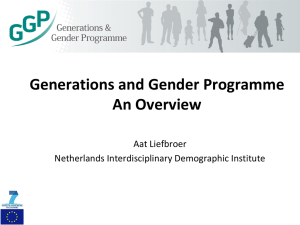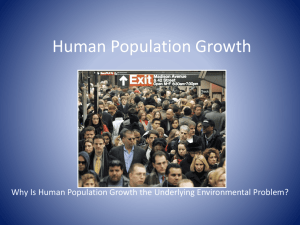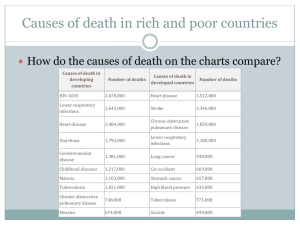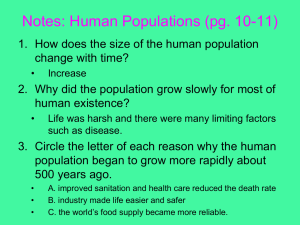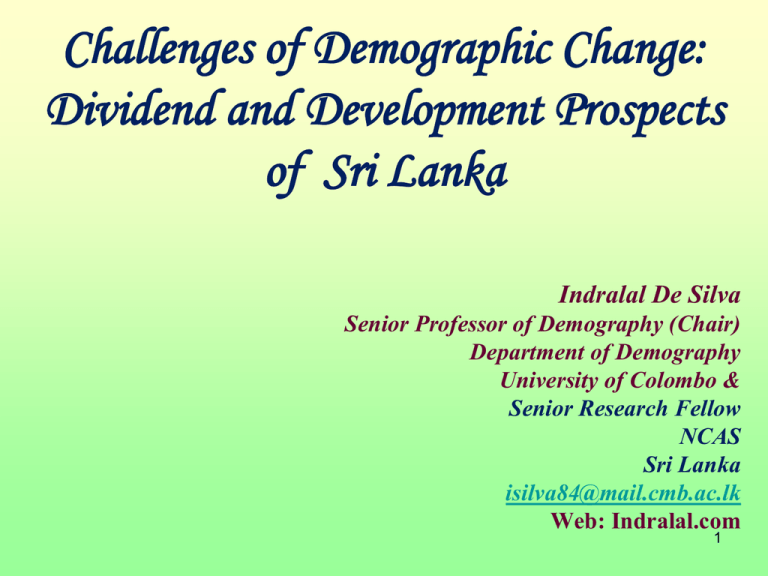
Challenges of Demographic Change:
Dividend and Development Prospects
of Sri Lanka
Indralal De Silva
Senior Professor of Demography (Chair)
Department of Demography
University of Colombo &
Senior Research Fellow
NCAS
Sri Lanka
isilva84@mail.cmb.ac.lk
Web: Indralal.com
1
Sections to be discussed
Demographic transition
Past, present & future size of the population
Changes in the age & sex structure
Demographic dividend (bonus)
Labour force
Emerging population issues
Conclusions
2
Demographic Transition
• Mortality (deaths) of Sri Lanka declined since 1920s
• Fertility (births) of Sri Lanka declined since early 1960s.
However, since year 2000 it shows an increase
• Since 1970s, emigration (out bound) of Sri Lankans has
accelerated – net loser
Ageing is a by product of these trends
3
Life Expectancy at Birth (in years)
Year
Male
Female
Difference
(F – M)
1920 -1922
32.7
30.7
-2.0
1945 -1947
46.8
44.7
-2.1
1953
58.8
57.5
-1.3
1962 -1964
63.3
63.7
+0.4
1970 -1972
64.0
66.9
+2.9
1980 -1982
67.7
72.1
+4.4
2000-2002
68.1
76.6
+8.5
2011 (projected)
68.8
77.6
+8.8
Life expectancy at age 60 (in years), 2000-2002
Age
Male
Female
At age 60
17.2
21.3
4
Fertility Transition
Year
Total Fertility
Rate –TFR
(No. of live births per
woman)
1953
5.32
1963
5.33
Total fertility rate - TFR
6
5
4
1971
4.16
3
1981
3.45
1995-2000
1.96
2003-2006
(1.8)
2.30
2
1
0
1953
1963
1971
1981
1995-2000 2001-2006
5
International Migration
Period
Arrivals
Departures
Net gain/Lost
2000 - 2004
5,574,387
5,634,152
-59,765
2005 - 2008
6,004,207
6,144,351
-140,144
2009 - 2012
8,679,380
8,828,603
-149,223
Large no. has migrated - Semi or permanent manner
Departures for foreign employment
2009
2010
2011
2012
247,126
266,445
263,960
271,000
Labour shortages - Importation of foreign workers -Remittances6
Departures for Foreign Employment
160000
140000
133251
126468
120000
137394
128821
116015
123200
100000
111778
105949
96807
93896
90170
80000
70522
Female
63720
60000
43791
40000
0
53867
32269
16044
11023
5433
16377
8680
1986
1987
1988
1989
1990
1991
1992
1993
1994
1995
1996
1997
1998
1999
2000
2001
2002
2003
2004
2005
2006
2007
2008
20000
46021
7
Population Growth
1871
2.4 million
After 54 years
1925
4.8 million
After 35 years
1960
9.6 million
After 43 years
2003
19.2 million
8
Change of Population, Sri Lanka
Year
Population size (in
millions)
Median age (in years)
1971
12.7
25.0
1981
14.8
26.7
2001
18.7
27.9
20.5
31.6
2021
21.5
35.8
2031
21.9
39.6
2041
21.7
42.4
2011
Census 2012 =20.3
At present the rate of population growth is only 0.7% (2001-2012).
The total population will never get doubled in the future.
Is this true with the elderly population?
9
Population Growth and Size
25
1.4
1.2
Population size
20
0.8
15
0.6
10
0.4
0.2
Growth rate
5
0
0
1991-96
1996-01
2001-06
2006-11
2011-16
2016-21
2021-26
2026-31
2031-36
-0.2
10
2036-41
Growth rate (percentage)
Population (millions)
1
Sex Ratio (Number of males per 100 females)
Year
Sex Ratio
(Total Population)
1971
106.1
121.8
1981
104.0
112.9
2001
97.9
96.7
97.5
90.8
2011
Census 2012 =94.3
Sex Ratio
(Population 60+)
Sex ratio of the total population reported in 2012 census is 94.
For every 100 females there was only 94 men.
Sex ratio of the elderly in 2011 would have been around 90.
11
Change of the Age Structure
Year
Age group (%)
60+
15-59
<15
1971
6.3
54.7
39.0
1981
6.6
58.2
35.2
2001
9.2
64.5
26.3
2012
12.2 (12.5)
62.0
25.8 (22.8)
2016
14.5
64.2
21.3
2021
16.8
63.8
19.4
2031
20.7
63.2
16.1
2041
24.8
60.0
15.2
The projected proportion of elderly for 2012 is 12.5%, however the census figure is 12.2%.
The proportion of children is 25.8% in the census while projected value is 22.8%.
13
Population Age 60 and Over (in millions)
12.2%
7.9%
16.7%
20.7%
24.8%
9.2%
14
Distribution of Elderly by Age 1971 to 2041
Year
Percentage
Number(‘000)
60+
60-74
75+
1971
80.5
19.5
807
1981
78.9
21.1
986
1991
78.8
21.2
1,393
2001
76.3
23.7
1,916
2012
75.9
24.1
2,468
2021
75.8
24.2
3,997
2031
70.1
29.9
5,103
2041
67.2
32.8
6,305
Old-old category is increasing rapidly
15
Age Dependency Ratios
• 1996
Year
• 199Year
Age Groups
Child
Elderly
Total
(0-14)/(15-59)
(60+)/(15-59)
(0-14)+(60+)/(15-59)
1971
71.3
11.5
82.8
1981
60.5
11.3
71.8
2001
40.7
14.3
55.1
2012
41.6
19.7
61.3
2021*
30.4
26.2
56.6
2031*
25.5
32.8
58.3
2041*
25.3
41.4
66.7
2051*
26.5
51.2
77.7
2061*
26.5
57.6
84.1
2071*
28.4
64.0
92.3
16
Population ageing will bring a slowdown of labour force
How to address this issue and to achieve productive ageing:
- Policies could be aimed at increasing participation of
older workers
- Retirement age could be made more flexible (60
62, 65
- Identification of obstacles for employment of older
workers
- Improve the skills of older workers
- Improve the choices available to older workers
- Improving health status of older workers; key reason
for withdrawal from the L.M is the ill health - NCDs
17
Demographic dividend - bonus
(window of opportunity)
• Each country would under go a period comprising
“demographic bonus” during the age structure transition
• The demographic bonus would have a positive impact on
economic growth
• Newly industrialized countries such as Republic of Korea,
Singapore, Taiwan etc. have utilized the demographic
bonus effectively
• During demographic bonus, dependency will be at
minimum level; highest proportion of population will be
in working ages (15-59 or 15-64)
18
Demographic dividend (bonus)
(Lowest level of dependency exists)
Environment is conducive for economic takeoff ( 1991-2017)
It provides sustainable benefits to all segments of the population 19
Bonus alone not sufficient for take-off :
Lessons from East Asian tigers
• Political stability
• Savings & investment
• Productivity
• Knowledge Economy – skills gap
Increasing the mandatory retirement age till 65 years &
productive ageing would stretch the Demographic
Bonus further (say up to 2030)
20
Growth of Labour Force by Sex
(000’)
Year
Male
Female
Total
2010
5609
2896
8505
1990
4374
2594
6968
Growth
1235
302
1537
Ave. annual
growth rate (%)
1.24
0.55
1.00
Rate of growth of the female L.F. was significantly lower than the males –
why?
Emerging Population Issues
• Increase of fertility
• Ageing & disability
• Migration - labour
• Family transition - FHHH
• Social protection
22
Conclusions
Fertility, gender gap in life expectancy &
migration all indicate upward trend
Population will increase & then stabilize
Size & age-sex structure changing – Fe.
Proportion & number of elderly will increase
23
Demographic environment is conducive for
economic take-off. Presently lowest level of
dependency prevails. Rapid ageing could fade
away this favorable environment
The take-off could provide sustainable
benefits to all segments of the population
Demographic bonus alone would not
sufficient enough for Economic take-off
It is an opportunity that should not be
24
missed

